您好,登錄后才能下訂單哦!
您好,登錄后才能下訂單哦!
這篇文章主要講解了“Spring Boot集成Swagger2怎么構建API文檔”,文中的講解內容簡單清晰,易于學習與理解,下面請大家跟著小編的思路慢慢深入,一起來研究和學習“Spring Boot集成Swagger2怎么構建API文檔”吧!
Swagger 是一種接口描述語言,主要用于生成、描述、調用以及可視化 RESTful 風格的 Web 服務接口文檔。以前的項目可能更多的是前后端未分開同時進行開發,所以接口文檔可能不是那么重要。但現在主流的項目基本都是前后端分離,如果前后端沒有溝通好,就有可能導致接口文檔更新不及時,造成一些不必要的麻煩。而通俗地講,Swagger 就是幫我們寫接口文檔的。它不僅能自動生成實時接口文檔,還能生成測試用例,方便我們進行測試。
Swagger 主要提供了如下幾種開源工具:
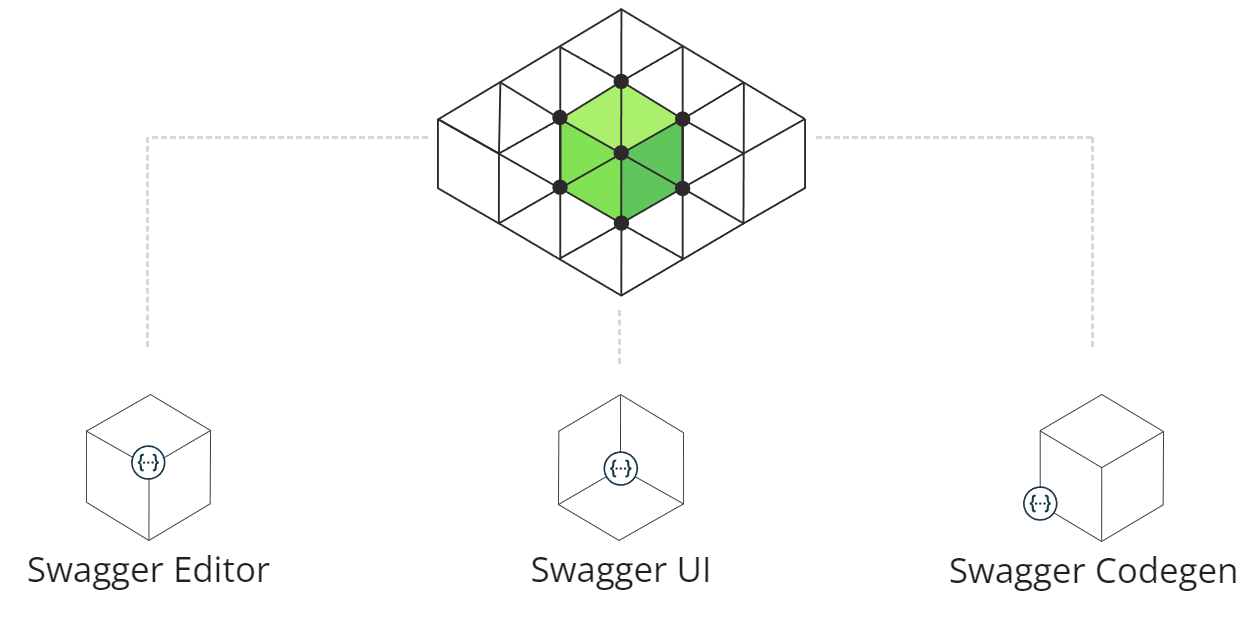
Swagger 所提供的的編輯器,主要用于編輯 Swagger 描述文件,支持實時預覽描述文件更新后的效果,類似于我們的 Markdown 編輯器,左邊編寫源碼,右邊就可以進行實時預覽。該編輯器不僅提供在線使用,還支持本地部署。
提供可視化的 UI 頁面,用于展示 Swagger 的描述文件。接口的調用方、測試等都可以通過該頁面查閱接口的相關信息,并且進行簡單的接口請求測試。
通過使用該工具,可以將 Swagger 的描述文件生成 HTML 和 CWIKI 形式的接口文檔,而且還能生成針對多種不同語言的服務端和客戶端的代碼。
平時和我們打交道最多的,可能就是 Swagger UI 這個工具了,它主要用于顯示接口文檔。根據我們代碼中按照 Swagger 規范所設置的描述,自動生成接口說明文檔。一個簡單的示例如下:

通過以上對 Swagger 簡單的介紹之后,我們來看看如何在 Spring Boot 項目中使用 Swagger。
首先需要創建一個簡單的 Spring Boot 項目,如果你還不知道如何創建,
創建好之后的項目接口如下:
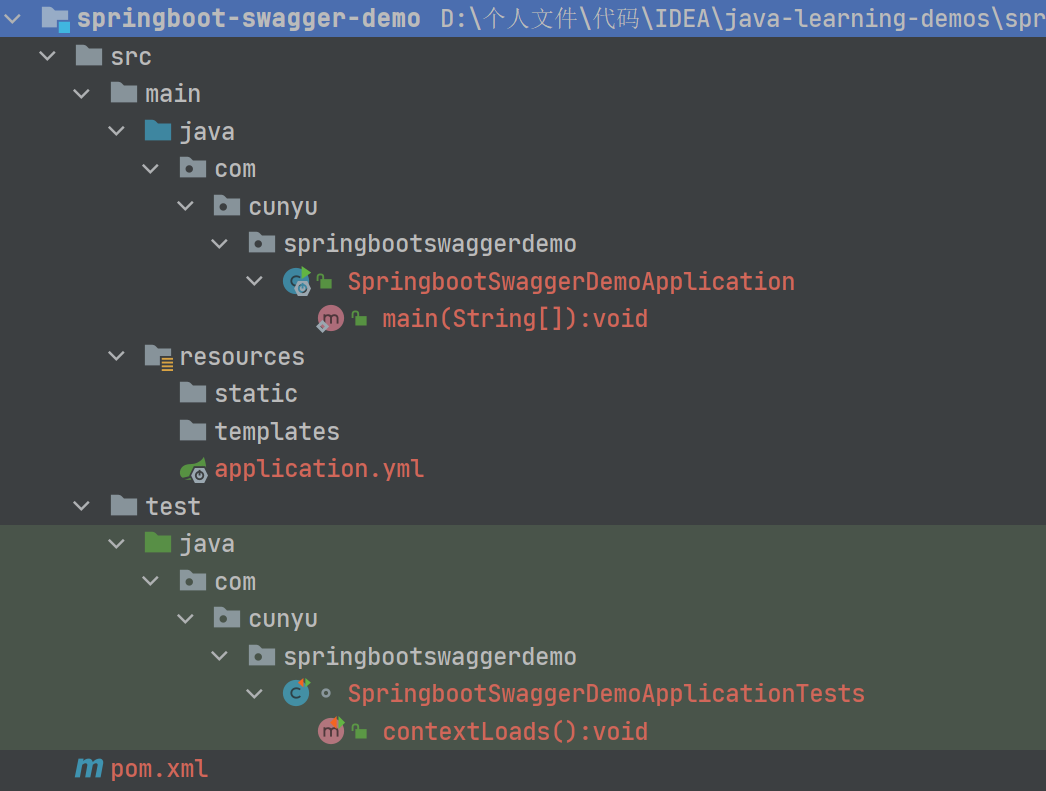
創建好Spring Boot 項目之后,需要配置項目 pom.xml 文件,在其中引入 Swagger 的相關依賴。
<dependency> <groupId>io.springfox</groupId> <artifactId>springfox-swagger2</artifactId> <version>2.9.2</version> </dependency> <dependency> <groupId>io.springfox</groupId> <artifactId>springfox-swagger-ui</artifactId> <version>2.9.2</version> </dependency>
引入依賴后,接下來就是構建 Swagger 的配置類了。
package com.cunyu.springbootswaggerdemo.config;
import org.springframework.context.annotation.Bean;
import org.springframework.context.annotation.Configuration;
import springfox.documentation.builders.RequestHandlerSelectors;
import springfox.documentation.service.ApiInfo;
import springfox.documentation.service.Contact;
import springfox.documentation.spi.DocumentationType;
import springfox.documentation.spring.web.plugins.Docket;
import springfox.documentation.swagger2.annotations.EnableSwagger2;
import java.util.ArrayList;
/**
* Created with IntelliJ IDEA.
*
* @author : 村雨遙
* @version : 1.0
* @project : springboot-swagger-demo
* @package : com.cunyu.springbootswaggerdemo.config
* @className : Swagger2Configuration
* @createTime : 2022/1/5 22:21
* @email : 747731461@qq.com
* @微信 : cunyu1024
* @公眾號 : 村雨遙
* @網站 : https://cunyu1943.github.io
* @description :
*/
@Configuration
@EnableSwagger2
public class Swagger2Configuration {
/**
* 配置 Swagger 2
* 注冊一個 Bean 屬性
* enable():是否啟用 Swagger,啟用后才能在瀏覽器中進行訪問
* groupName():用于配置 API 文檔的分組
*/
@Bean
public Docket docket() {
return new Docket(DocumentationType.SWAGGER_2)
.apiInfo(apiInfo())
.enable(true)
.groupName("v1")
.select()
// 過濾路徑
//.paths(PathSelectors.ant())
// 指定掃描的包
.apis(RequestHandlerSelectors.basePackage("com.cunyu.springbootswaggerdemo.controller"))
.build();
}
private ApiInfo apiInfo() {
/*作者信息*/
Contact contact = new Contact("村雨遙", "https://cunyu1943.github.io", "747731461@qq.com");
return new ApiInfo(
"Swagger 測試接口文檔",
"Spring Boot 集成 Swagger 測試接口文檔",
"v1.0",
"https://cunyu1943.github.io",
contact,
"Apache 2.0",
"http://www.apache.org/licenses/LICENSE-2.0",
new ArrayList()
);
}
}配置好 Swagger 后,在我們的項目中添加一個簡單的接口,這里以一個簡單的有參和無參接口為例。
package com.cunyu.springbootswaggerdemo.controller;
import io.swagger.annotations.Api;
import io.swagger.annotations.ApiOperation;
import io.swagger.annotations.ApiParam;
import org.springframework.web.bind.annotation.GetMapping;
import org.springframework.web.bind.annotation.PostMapping;
import org.springframework.web.bind.annotation.RestController;
/**
* Created with IntelliJ IDEA.
*
* @author : 村雨遙
* @version : 1.0
* @project : springboot-swagger-demo
* @package : com.cunyu.springbootswaggerdemo.controller
* @className : SwaggerDemoController
* @createTime : 2022/1/5 22:21
* @email : 747731461@qq.com
* @微信 : cunyu1024
* @公眾號 : 村雨遙
* @網站 : https://cunyu1943.github.io
* @description :
*/
@Api
@RestController
public class SwaggerDemoController {
@ApiOperation(value = "hello world 接口")
@GetMapping("hello")
public String hello() {
return "hello world";
}
@ApiOperation(value = "有參接口")
@PostMapping("demo")
public String demo(@ApiParam(name = "name", value = "村雨遙", required = true) String name) {
return "hello," + name;
}
}完成上述步驟后,我們啟動項目,然后在瀏覽器中訪問如下地址,就可以訪問我們項目的接口文檔了。
http://localhost:8080/swagger-ui.html
訪問如上地址后,如果出現下面的界面,說明我們 Spring Boot 集成 Swagger2 就到此成功了。

點開具體的接口,就會有這個接口的一些詳細信息,如下圖所示,一般包括:
接口請求方式
接口請求路徑及描述
接口請求參數
接口響應
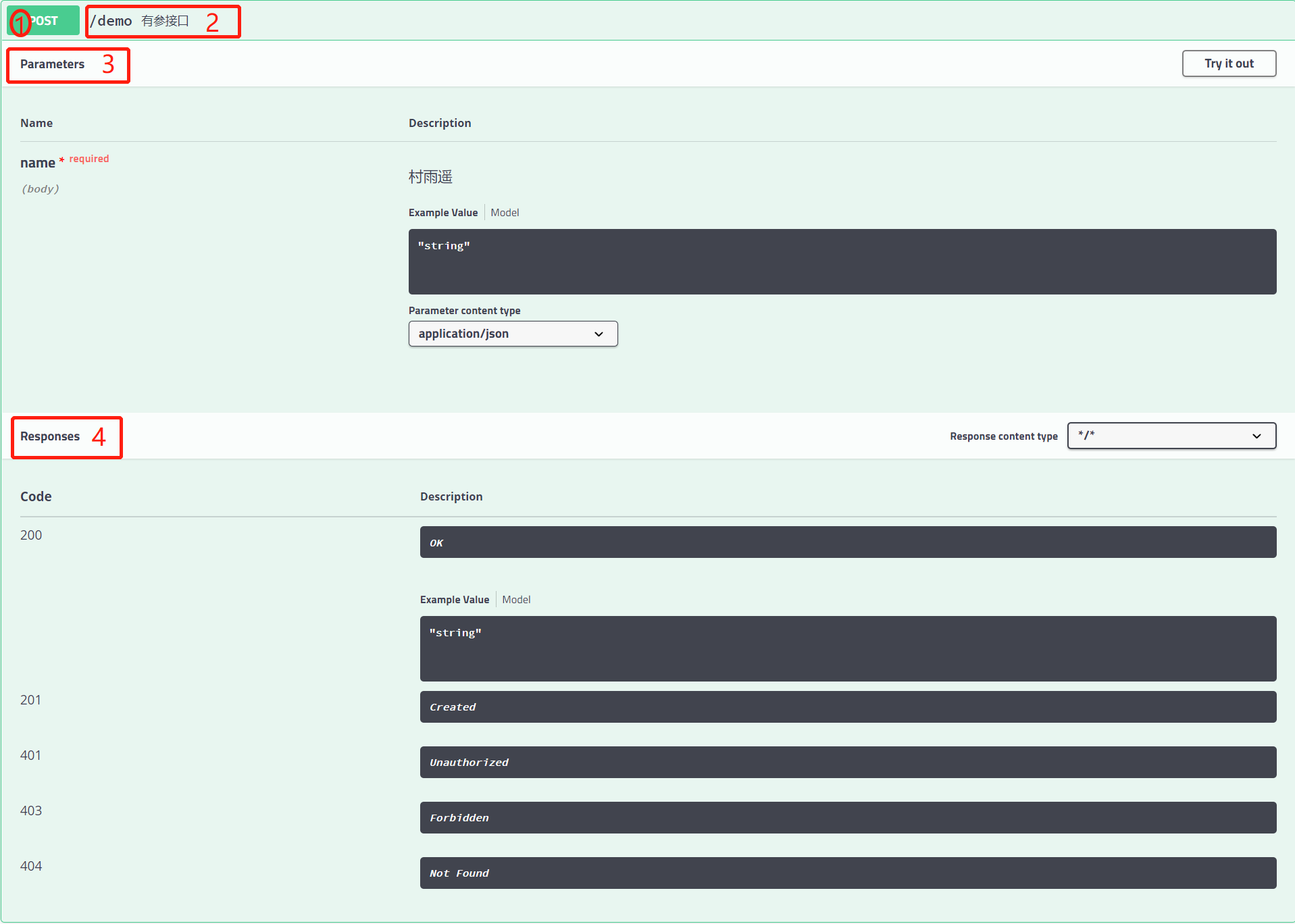
如果我們要進行簡單的測試,則點擊上圖中右上方的 Try it out,然后我們就可以編輯請求參數的值,編輯完成之后點擊下方的 Execute 即可查看接口返回值。
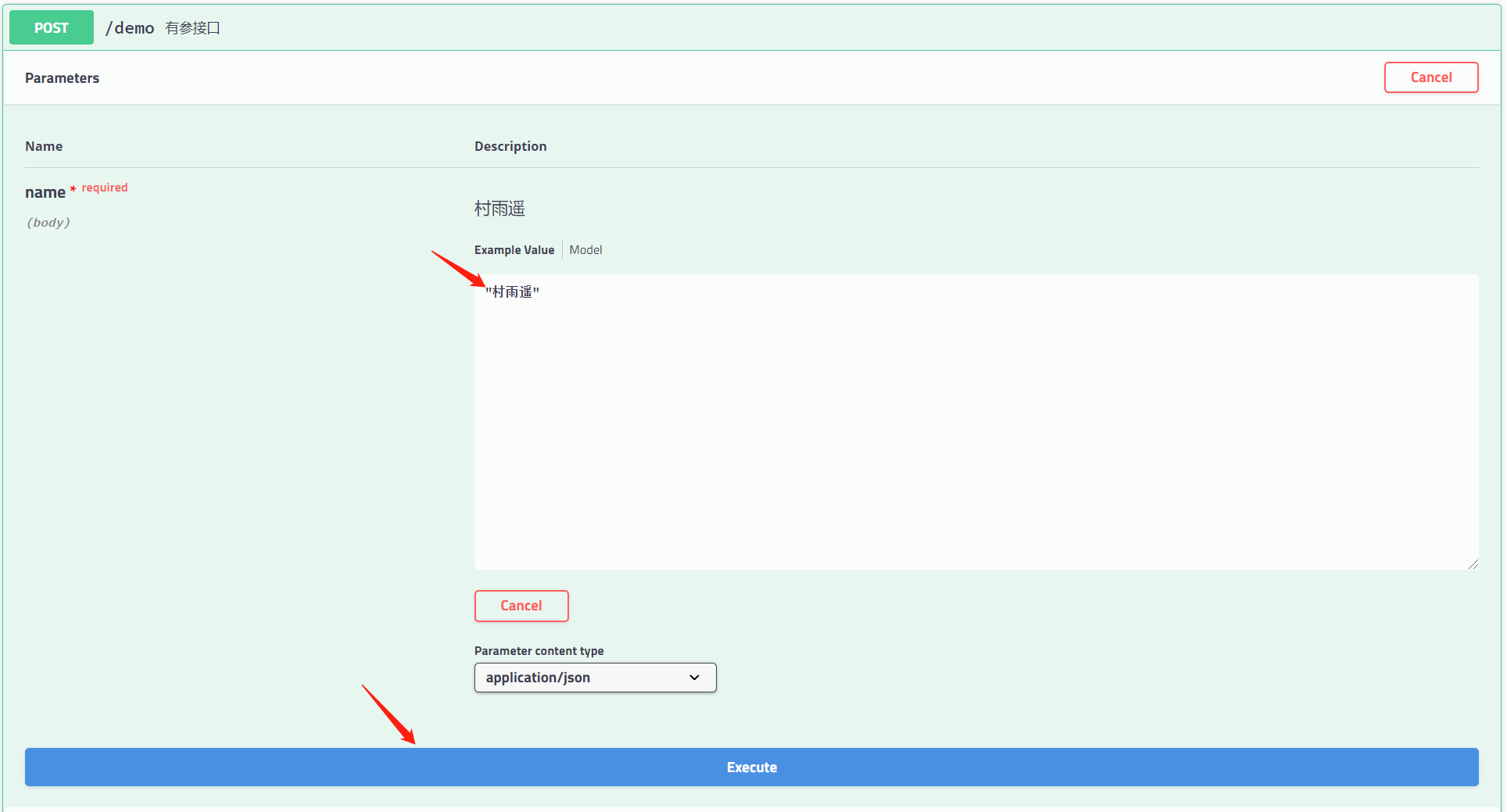
以我給的接口為例,我傳入了一個參數 name,然后執行 demo 接口,最后會給我返回 hello,name 的結果,其中 name 是我傳入的參數值,這里我傳入了村雨遙,所以結果應該會得到 hello,村雨遙,可以看到 Swagger 測試中也給我返回了對應的結果,說明我們的接口測試成功!
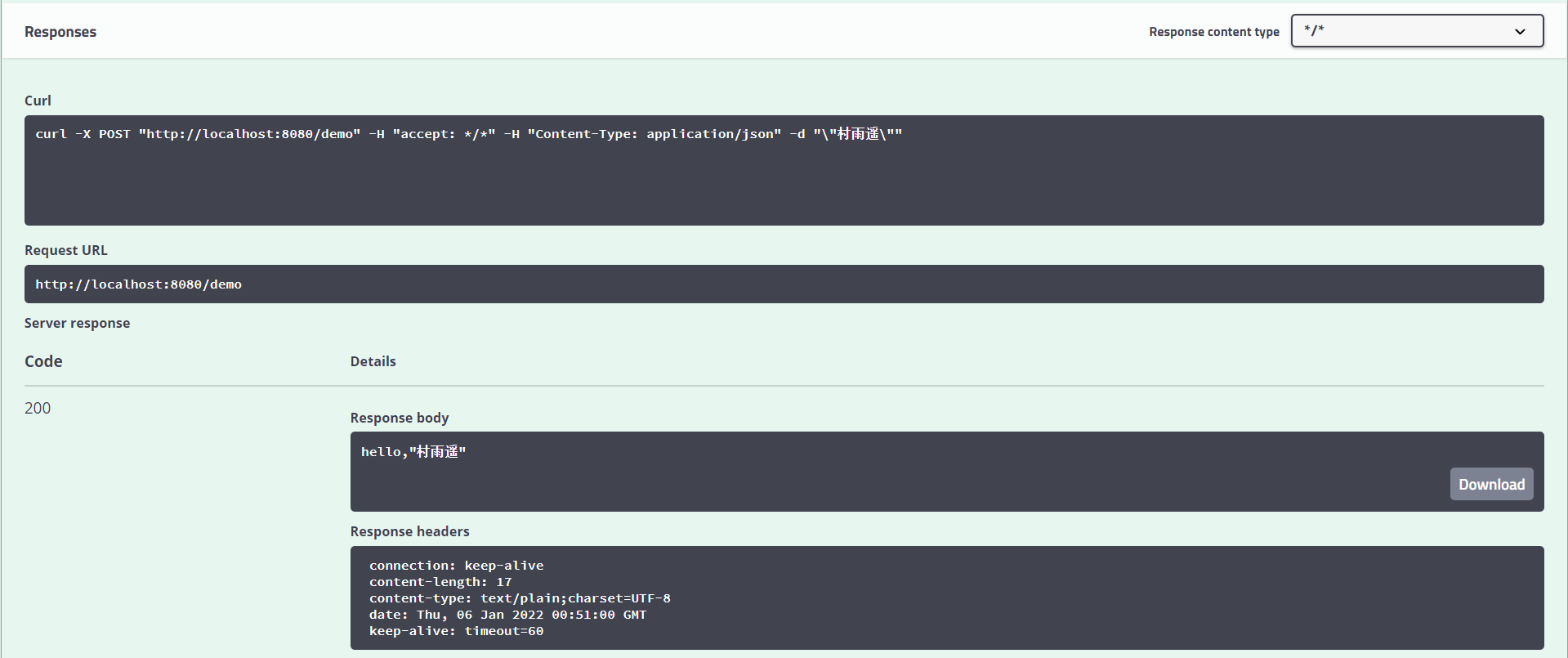
注意:
如果在整合過程中出現如下錯誤:org.springframework.context.ApplicationContextException:Failed to start bean 'documentationPluginsBootstrapper'; nested exception is java.lang.NullPointerException
這里可能是由于 Spring Boot 版本過高導致,我寫作本文時,一開始使用的 SpringBoot 2.6.2 版本,所以出現了該錯誤,而當我將 SpringBoot 降級為 2.5.6 時,該錯誤就不再出現。所以如果你也出現了這個問題,也可以嘗試降低 SpringBoot 版本來解決。
感謝各位的閱讀,以上就是“Spring Boot集成Swagger2怎么構建API文檔”的內容了,經過本文的學習后,相信大家對Spring Boot集成Swagger2怎么構建API文檔這一問題有了更深刻的體會,具體使用情況還需要大家實踐驗證。這里是億速云,小編將為大家推送更多相關知識點的文章,歡迎關注!
免責聲明:本站發布的內容(圖片、視頻和文字)以原創、轉載和分享為主,文章觀點不代表本網站立場,如果涉及侵權請聯系站長郵箱:is@yisu.com進行舉報,并提供相關證據,一經查實,將立刻刪除涉嫌侵權內容。